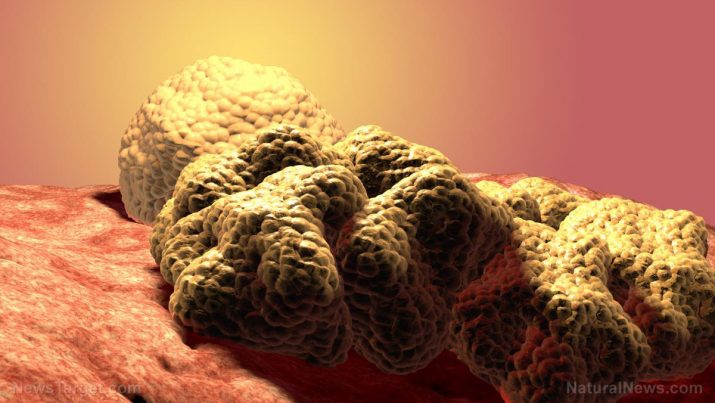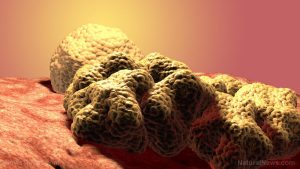
Benign adrenal adenoma/tumors – causes, side effects and treatments at NaturalPedia.com
Saturday, January 13, 2018 by Janine Acero
http://www.naturalpedia.com/benign-adrenal-adenomatumors-causes-side-effects-and-treatments-at-naturalpedia-com.html

The adrenals are two small glands that sit on top of each kidney. They are responsible for managing blood sugar levels, regulating the balance of salt and water, and controlling sexual maturity.
A benign adrenal adenoma is the most common type of adrenal gland tumor. It is a noncancerous, nonfunctioning tumor of the adrenal cortex. Also called an adrenocortical adenoma, it is found in almost all age groups but may increase in frequency with age.
In all cases, but especially in the setting of known current or previous malignancy, adrenal adenoma needs to be distinguished from adrenal metastases or other adrenal malignancies.

Known risks and symptoms of benign adrenal adenoma/tumors
Majority of the cases of adrenal adenoma are non-functioning, and therefore do not present any signs and symptoms. However, adrenal insufficiency may occur if both adrenal glands are affected.
Functional adrenal tumors are still able to produce adrenal hormones, albeit excessively. Because of this, the symptoms may depend on the type of hormones produced. Some of the conditions it can cause include Cushing’s syndrome and primary aldosteronism.
High levels of the hormone cortisol in the body cause Cushing’s syndrome, with particular symptoms such as upper body obesity, severe fatigue and muscle weakness, high blood pressure, high blood sugar, backache, easy bruising, appearance of bluish-red stretch marks on the skin, and increased growth of masculine characteristics in women such as facial and body hair.
Meanwhile, high levels of the hormone aldosterone affect the balance of sodium and potassium in the blood. This may result in such symptoms like elevated blood pressure, muscle weakness, headache and intermittent paralysis.
Other known symptoms of functional adrenal tumors include the following, though note that the cause of a symptom may be another medical condition rather than a tumor:
- Muscle cramps
- Heart palpitations
- Nervousness
- Feelings of anxiety or panic attacks
- Excessive perspiration
- Abdominal pain
- Unexplained weight gain, usually around the abdomen, or weight loss
- Abdominal stretch marks
- Fat deposits behind the neck and shoulders
- Changes in genitalia
- Unusual acne
- Easy bruising
- Menstrual irregularities
- Change in libido or sex drive
- Weakened bones (osteoporosis), which can lead to fractures
- High blood sugar, often leading to diabetes
- Overall weakness
- Depression and/or moodiness
If you experience these symptoms, it is best to check with your healthcare provider if these are indeed caused by a tumor or another health issue.
Body systems harmed by benign adrenal adenoma/tumors
Both functional and nonfunctional adenoma affect the endocrine glands (adrenal glands), causing them to produce abnormal amounts of hormones. Functional tumors also affect blood pressure and blood sugar levels, and may cause changes in the genitalia or sex organs of affected individuals.
Food items or nutrients that may prevent benign adrenal adenoma/tumors
Foods packed with potassium help to keep the sodium and potassium levels balanced in the body, which is critical for optimal functioning of the adrenals. Calcium and magnesium, L-tyrosine, and vitamins A, B(s) and C are also important in stress regulation and adrenal function.
Keep your adrenals healthy with the following list of foods rich in the above nutrients:
- All medicinal mushrooms, particularly shiitake mushrooms
- Almonds
- Avocados
- Bananas
- Beef
- Berries
- Brazil nuts
- Broccoli
- Brussels sprouts
- Celery
- Chicken
- Dried dates
- Dried figs
- Fish
- Hemp seeds
- Kale
- Kidney beans
- Legumes
- Lemons
- Mangoes
- Millet
- Oats
- Oranges
- Parsley
- Peaches
- Potatoes
- Seaweed, particularly kelp
- Spring greens
- Squash
- Swiss chard
- Tomatoes
- Tuna
- Turkey
- Walnuts
- Wheat
- Yams
Treatments, management plans for benign adrenal adenoma/tumors
For individuals with nonfunctional adrenal tumors, it is advisable to have a CT scan and MRI every six to 24 months to detect any changes in the size of the tumor. Blood hormone level tests may also be ordered to see if the tumor has started producing hormones.
Meanwhile, the preferred treatment method for functional adrenal tumors is robotic laproscopic removal of the tumor or infected tissue. Many times this involves an adrenalectomy, or the removal of the whole adrenal gland. Once the tumor has been removed, other symptoms caused by the condition will resolve as well.
Where to learn more
- Do you or a loved one suffer from CTS – Critical Thinking Syndrome?
- Children’s medicines coated with brain-damaging aluminum
- Most popular protein powders loaded with artificial sweeteners, modified (GMO) corn starch and toxic dyes
- Artificial Food Coloring – You’re eating petroleum-based industrial chemicals!
- The food industry is waging war on your cells with these 10 toxic ingredients
Summary
A benign adrenal adenoma, also known as adrenocortical adenoma, is the most common type of adrenal gland tumor. It is a noncancerous, nonfunctioning tumor of the adrenal cortex. It is found in almost all age groups but may increase in frequency with age.
Sources include:
Tagged Under: Tags: Benign adrenal adenoma/tumors





